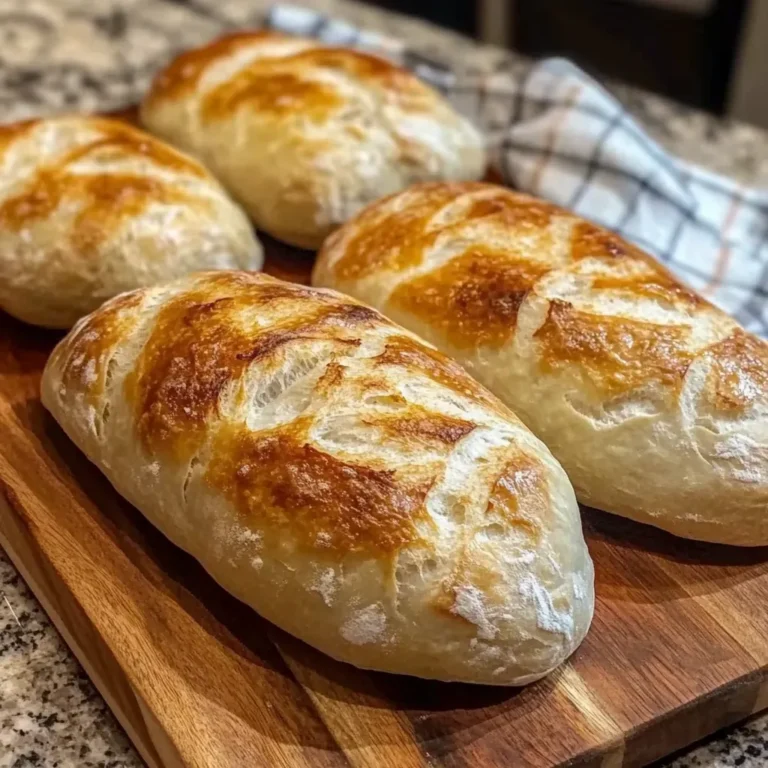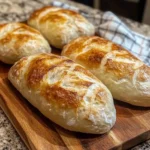Introduction
Italian ciabatta is a rustic Italian bread known for its airy crumb, crisp crust, and distinctively slipper-like shape. As a staple in Italian cuisine, it plays a vital role in both traditional meals and modern culinary creations. Originating in Italy in the early 1980s, this bread has quickly earned a spot on bakery shelves and restaurant menus across the globe.
Its versatility makes it a favorite in many households — perfect for paninis, bruschetta, or simply enjoyed with a drizzle of olive oil. Whether served with soup or used as a sandwich base, ciabatta offers a chewy texture and rich flavor that continues to charm food lovers everywhere.
Origins and History
- The term ciabatta means “slipper” in Italian, a reference to the bread’s long, flat shape. This name reflects its humble, everyday appeal and artisan roots. According to Wikipedia, the shape was intentionally chosen to create a contrast with the thinner French baguette.
- Ciabatta was created in 1982 by Arnaldo Cavallari in Adria, Veneto. Cavallari, a passionate miller and baker, developed it in response to the rising popularity of French baguettes in Italy. His goal was to craft an Italian alternative with a distinct texture and flavor. More about this fascinating history can be found on Brown Eyed Baker, who shares stories alongside recipes, and Wikipedia – Die freie Enzyklopädie.
- Over time, ciabatta spread across Italy, with each region introducing its own variations. By the mid-1980s, it had made its way to the UK and US, quickly becoming a beloved choice in bakeries and cafes thanks to its hearty structure and rustic charm.
Traditional Characteristics of Ciabatta
- Ciabatta is typically shaped as an elongated, flat loaf, resembling a worn house slipper. Its unique structure sets it apart from more uniform bread types like rolls or baguettes. According to Wikipedia, this shape contributes to its name and identity in Italian baking.
- What truly distinguishes ciabatta is its open, porous crumb and crisp, golden crust. These qualities are achieved through a high hydration dough and a delicate mixing process. Sally’s Baking Addiction, along with the practical kitchen and Alexandra’s Kitchen, detail how the hydration and minimal kneading help maintain those signature air pockets.
- Compared to focaccia, which is denser and baked in pans, ciabatta is lighter with more chew. And unlike baguettes, which are longer and crustier, ciabatta offers a moister interior, ideal for absorbing sauces or toasting for sandwiches.
Ingredients and Their Roles
- Authentic ciabatta relies on just a few simple but essential ingredients:
- High-gluten bread flour for strength and chew.
- Water in high quantities to create the moist, open crumb.
- Yeast to initiate fermentation and rise.
- Salt for flavor balance.
- Optional olive oil for a tender bite and added richness.
- The high hydration level (typically around 75–80%) is crucial for ciabatta’s unique texture. As noted by the practical kitchen and Alexandra’s Kitchen, this wet dough requires a gentle folding technique rather than traditional kneading to develop gluten while maintaining the airy structure.
- Many bakers use a preferment like biga or poolish to enhance flavor and dough development. These overnight ferments introduce a mild tang and improve the bread’s structure, resulting in that perfect balance between crispy exterior and chewy, hole-filled interior. Wikipedia – Die freie Enzyklopädie further explains how these techniques elevate ciabatta from a basic loaf to a bakery-style masterpiece.
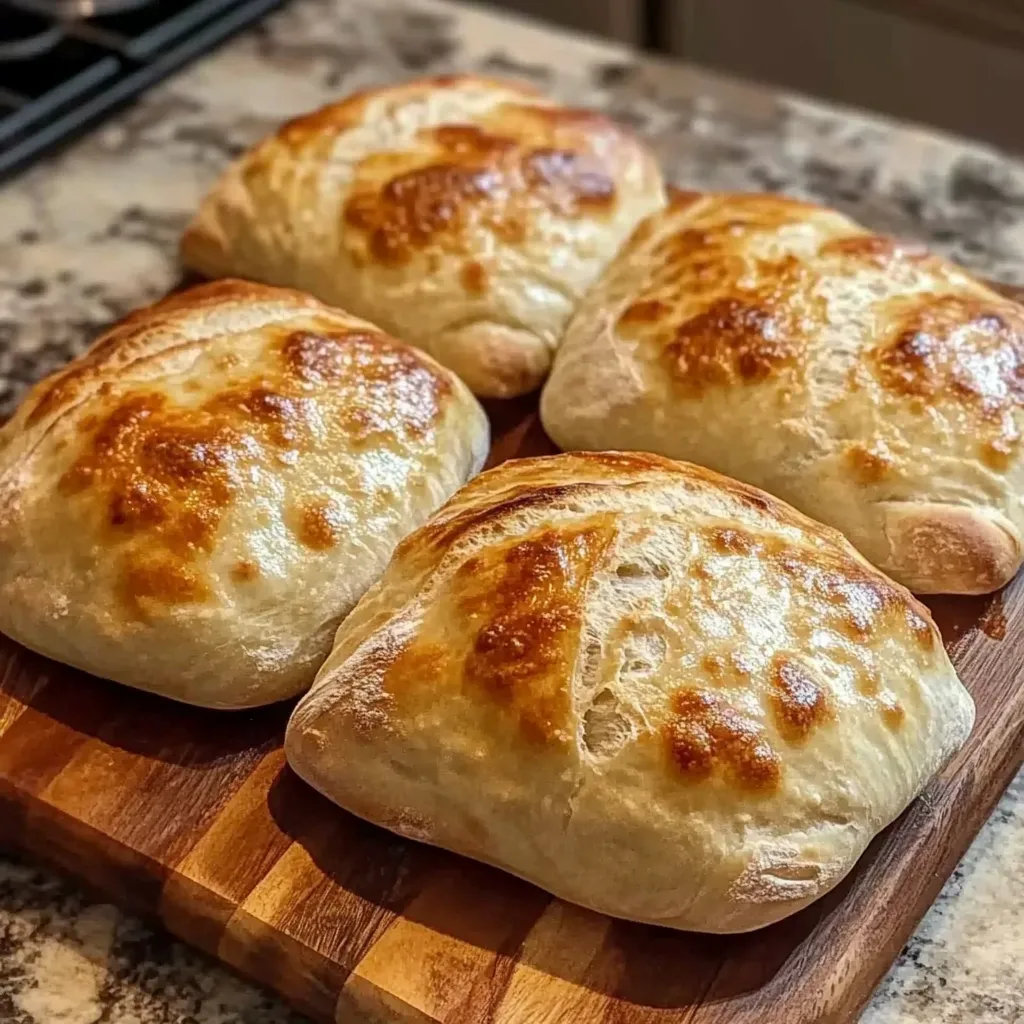
Traditional Ciabatta Preparation Method
Crafting authentic Italian ciabatta involves a series of carefully timed steps that result in its iconic airy crumb and crisp crust. While the process takes time, each stage contributes to the depth of flavor and texture that defines this beloved bread.
- Making the Biga (Preferment):
To begin, a preferment known as biga is made by combining flour, a small amount of yeast, and water. This mixture is left to ferment for 12 to 24 hours. The long fermentation period not only boosts flavor but also strengthens the dough’s gluten structure, making it more resilient during shaping and baking. A well-developed biga adds the slightly tangy note ciabatta is known for. - Mixing the Dough:
Once the biga is bubbly and ripe, it’s mixed with additional high-gluten flour, water, yeast, and salt to form the main dough. This mixture results in a wet, sticky consistency that can be tricky to handle at first. However, this high hydration is crucial to achieve the bread’s signature holes and open crumb. As described on Alexandra’s Kitchen, patience is key when working with this kind of dough. - Fermentation and Folding:
Instead of kneading, a series of gentle stretch and fold techniques are used. These folds, performed every 30 minutes during bulk fermentation, help to build structure while maintaining an airy interior. According to the practical kitchen, this method encourages gluten development without deflating the dough. The dough is then allowed to rise until doubled in size. - Shaping and Proofing:
Once risen, the dough is turned out onto a heavily floured surface. To preserve its delicate air bubbles, it’s shaped gently into rustic loaves. After shaping, the loaves rest on a floured surface or parchment to proof, expanding slightly while maintaining their structure. - Baking:
The oven should be preheated to a high temperature — around 450°F (230°C). Adding steam at the beginning of baking (either by using a pan of hot water or spraying the oven walls) helps achieve a crackly crust. The loaves are baked until they develop a deep golden color and sound hollow when tapped.
Regional Variations of Italian Ciabatta
Though the classic ciabatta originated in Veneto, regional adaptations throughout Italy offer exciting variations in texture and flavor, each reflecting local preferences and baking traditions.
- Lake Como Ciabatta:
This version is known for its extremely porous interior and crisp, blistered crust. Its open crumb and light structure make it especially suitable for sandwiches or toasting. As mentioned on Wikipedia and the practical kitchen, this style closely resembles what most people outside of Italy recognize as “classic ciabatta.” - Tuscan, Umbrian, and Marche Versions:
In these central regions, ciabatta tends to have a slightly denser crumb and firmer crust. While still airy, the texture is less exaggerated compared to the northern styles. According to Wikipedia, these loaves are often heartier, suited to holding up against rich meats and cheeses. - Roman Ciabatta:
Rome’s take on ciabatta adds a flavorful twist. Bakers often season the dough with herbs such as marjoram or oregano, enhancing its aroma and taste. This herbed version pairs beautifully with antipasti or a glass of red wine, offering a fragrant alternative to the more neutral varieties.
Modern Adaptations and Global Influence of Italian Ciabatta
Italian ciabatta made its international debut in the mid-1980s, quickly captivating bakers and consumers alike with its rustic charm and soft, airy texture. In 1985, the UK embraced ciabatta through a commercial launch by Marks & Spencer, introducing British palates to this unique slipper-shaped bread. Shortly after, in 1987, it was brought to the US by Orlando Bakery, marking a turning point in its global spread. According to Wikipedia and the practical kitchen, these introductions sparked widespread popularity across Western markets.
Today, numerous modern variations of ciabatta have emerged to suit diverse tastes and dietary needs. Varieties like ciabatta integrale (made with whole wheat flour) offer a denser texture and higher fiber content, while ciabatta al latte includes milk in the dough for a softer crumb and richer flavor. Moreover, contemporary recipes often include flavorful additions such as olives, sun-dried tomatoes, rosemary, or even cheese, transforming this traditional bread into a versatile canvas for culinary creativity.
These global reinterpretations continue to highlight ciabatta’s adaptability while preserving the essence of its Italian roots.
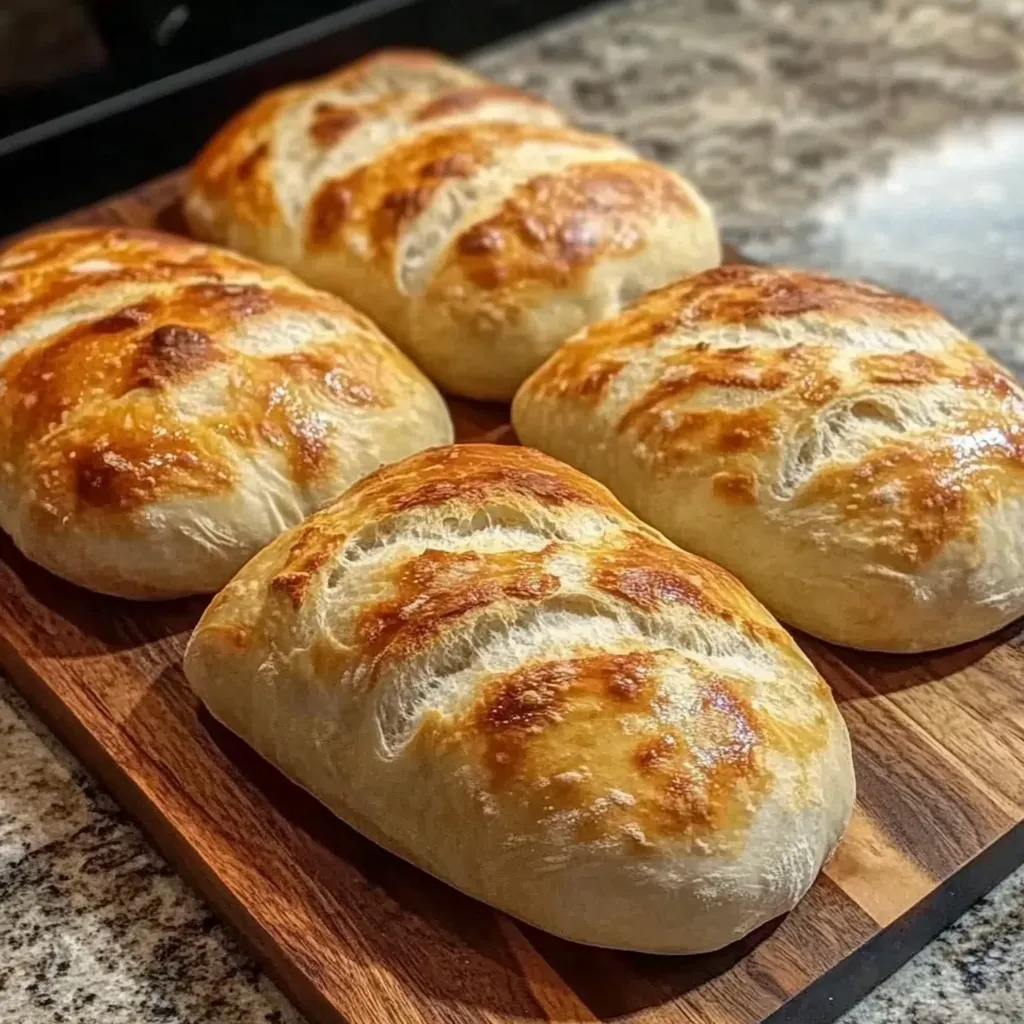
Culinary Uses and Pairings for Italian Ciabatta
Thanks to its sturdy yet airy structure, ciabatta is a top choice for a variety of savory and creative applications. Its chewy crumb and crisp exterior hold up exceptionally well under toppings and fillings.
- One of the most popular uses is for sandwiches and paninis, where the bread’s texture withstands heat and moisture without becoming soggy.
- Ciabatta also shines when dipped in olive oil, infused with herbs or balsamic vinegar, or served alongside hearty soups and stews for a rustic touch.
- For appetizers, it’s ideal for making bruschetta, especially when lightly toasted and topped with fresh tomatoes, basil, or creamy spreads.
- Pair ciabatta with Italian cheeses like mozzarella or gorgonzola, cured meats such as prosciutto or salami, and a bold glass of Chianti or a crisp white wine for a delicious, well-rounded experience.
Its versatility in both casual meals and elegant appetizers makes Italian ciabatta a timeless favorite in kitchens worldwide.
Nutritional Information and Dietary Considerations
While ciabatta bread is known more for its texture and flavor than low-calorie content, it can still be enjoyed as part of a balanced diet. A standard serving (about 50g) of white ciabatta typically contains around 130–150 calories, 28g of carbohydrates, 5g of protein, and 1g of fat.
For those seeking healthier options, whole-wheat ciabatta or ciabatta integrale offers added fiber and a slightly nuttier flavor. These variations can be a better choice for those monitoring their blood sugar or aiming to increase daily fiber intake.
However, due to its high gluten content, ciabatta is not suitable for individuals with celiac disease or gluten sensitivity. For gluten-free alternatives, specialty bakeries may offer modified recipes using rice flour or tapioca starch, though the texture will differ.
Tips and Tricks for Perfect Homemade Ciabatta
Making authentic Italian ciabatta at home is incredibly rewarding, especially when you understand a few key techniques that make all the difference.
- Handling high-hydration doughs can be tricky, so it’s important to work with wet hands and use a dough scraper to manage stickiness.
- Allowing proper fermentation time is crucial — don’t rush the process. Long fermentation develops flavor and gives the dough structure.
- To achieve the signature open crumb, use gentle folding techniques instead of kneading. Overhandling can collapse the air bubbles you worked hard to create.
- For freshness, store ciabatta in a paper bag at room temperature for 1–2 days. For longer storage, slice and freeze the loaves in airtight containers, then reheat in the oven for best results.
Common Mistakes and Troubleshooting When Making Italian Ciabatta
Even experienced bakers may face challenges when working with Italian ciabatta, especially due to its high hydration and delicate structure. Thankfully, most issues can be easily corrected with a few key adjustments.
- If the dough feels overly sticky or too dry, check your flour measurements and hydration level. A sticky dough is normal, but if it’s unmanageable, use lightly oiled hands and surfaces. For dry dough, gradually add small amounts of water until the texture softens.
- To prevent flat or dense loaves, be mindful of fermentation. Under-proofed dough will lack strength, while over-proofed dough collapses. Use stretch and fold methods to build gluten and trap gas during bulk fermentation.
- If the crust is too thick or overly chewy, it could be due to insufficient steam or baking too long. As the practical kitchen suggests, using steam and avoiding prolonged baking helps achieve that perfect crisp crust without hardness.
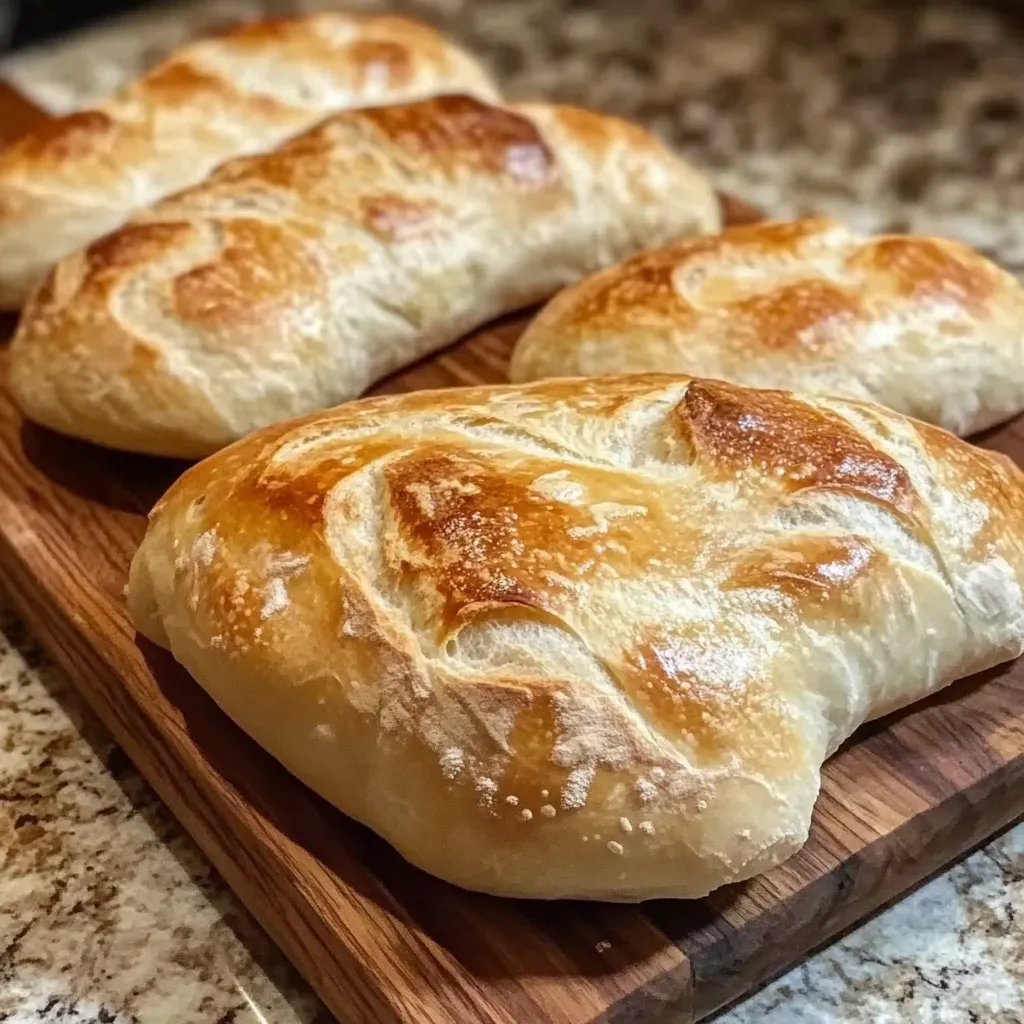
FAQs About Italian Ciabatta Bread
- Q: Can I make ciabatta without a preferment?
A: Yes, although using a biga improves texture and flavor, some quick recipes omit it. However, the crumb may be less open and the flavor less complex. - Q: How do I store ciabatta to keep it fresh?
A: For best freshness, store in a paper bag at room temperature. To preserve longer, freeze slices in airtight containers and reheat in the oven as needed. - Q: Can I add flavors like olives or herbs to the dough?
A: Absolutely. Add-ins like olives, sun-dried tomatoes, or rosemary work well and elevate your ciabatta with bold Mediterranean flavors. - Q: Why is my ciabatta dense and lacking holes?
A: This typically results from underproofing or handling the dough too aggressively. Allow enough time to rise and treat the dough gently to maintain air pockets.
Conclusion
From its roots in Veneto to its popularity across continents, Italian ciabatta remains a cherished bread for its chewy interior, crisp crust, and versatile use in everyday cooking. By understanding its traditional techniques, adapting it to your style, and avoiding common mistakes, you can master this classic bread at home. Whether served with soups, layered in paninis, or enjoyed with olive oil, ciabatta adds a touch of artisanal flair to every meal.
PrintItalian Ciabatta: A Classic Bread with Global Appeal
Classic Italian ciabatta bread with an airy crumb and golden, crisp crust. Perfect for sandwiches or dipping.
- Prep Time: 15 minutes (plus 12–24 hrs for preferment, if using)
- Cook Time: 25 minutes
- Total Time: 1 hr 40 mins (without preferment)
- Yield: 2 medium ciabatta loaves
- Category: Bread
- Method: Baking
- Cuisine: Italian
- Diet: Vegetarian
Ingredients
– 4 cups (500 g) bread flour
– 1½ cups (360 ml) warm water
– 1 packet (2¼ tsp) active dry yeast
– 2 tbsp (30 ml) olive oil
– 2 tsp (10 g) salt
Instructions
1. Mix yeast and warm water, let sit 10 mins.
2. Combine flour, salt, olive oil, and yeast mix.
3. Let rise 1–2 hrs until doubled.
4. Gently shape into loaves.
5. Proof 30–45 mins.
6. Bake at 450°F (230°C) for 20–25 mins.
7. Cool before slicing.
Notes
Handle dough gently to preserve bubbles. Add steam during baking for a crispier crust. Use a preferment for deeper flavor.

